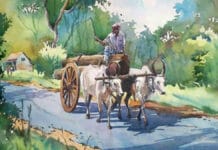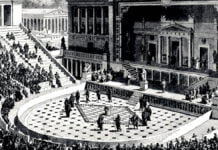Derek Walcott’s poem Ruins of a Great House follows the narrator as he walks through a decayed lime plantation in the Caribbean, built during colonial times. The poem’s narrator related the decaying of the mansion and its grounds to its past of oppressive imperialists. This poem examines many deep topics, such as the consequences of colonisation, the moral and ethical entanglement with the oppression and enslavement of the African people, and British brutality throughout history. This poem also creates an extended metaphor, linking British literature’s significant authors and their quotes. He truly idealises them but then connects them with the brutality of British colonialism, leading him to an ethical breakdown.
The title can be taken with a bit of irony and a literal sense. The house represents the British Empire, which shows some irony as the speaker does not consider the British Empire to be “great” at all. It also plays on words because “great” is used for Great Britain. In the literal sense, the title also means exactly what it says. The house was beautiful, outstanding, and great, and now it’s in ruins.
Summary
The poem begins with a striking image of a “great house” — a colonial mansion now in ruins. Once a symbol of power, wealth, and imperial dominance, the house is now dilapidated, with remnants of its former grandeur scattered in a decaying state. The ruin symbolises the crumbling of colonial power and the effects of empire on the land and people.
The ruin of the house is contrasted with the natural world, which is depicted as vibrant and unyielding despite the destructive forces of colonialism. This duality between the ruins of the house and the living landscape offers a striking metaphor for the persistence of Indigenous culture and history despite the ravages of colonial exploitation.
Walcott then shifts the focus to the relationship between the colonisers and the colonised. Through the imagery of overgrown gardens and broken structures, the poem highlights the loss of cultural identity, the displacement of Indigenous people, and the fragmentation of the Caribbean’s historical consciousness due to the destructive forces of colonialism. The house becomes an emblem of the colonial forces that sought to impose foreign values, leaving the Caribbean’s history and identity in ruins.
The poet’s reference to the ruins also speaks to the cultural amnesia experienced by the colonised. Walcott suggests that the great house, though physically decayed, continues to haunt the people in its memory, much like the lingering effects of colonialism on the psyche of the Caribbean people. The poem also reflects on the invisible scars left by imperialism, suggesting that these scars are part of the collective consciousness passed down through generations.
Throughout the poem, Walcott moves between personal reflection and historical commentary, tying the ruin of the house to the broader destruction of the Caribbean’s cultural and historical roots. Despite the tragic nature of the colonial legacy, Walcott’s imagery of the lush Caribbean landscape serves as a reminder of resilience, a symbol of the reclamation of identity in the face of cultural oppression.
Themes
Colonialism and its Aftermath
The central theme of Ruins of a Great House is the legacy of colonialism. The titular “great house” represents the power and control exerted by the colonial rulers over the Caribbean. The ruins of the house symbolise the collapse of the empire, but they also signify the lasting impact of colonisation on the land and its people. The poem explores how the physical remnants of the empire have become a reminder of loss and destruction but also a reflection of how this legacy still haunts the Caribbean.
Cultural Identity and Memory
Walcott uses the decaying mansion as a metaphor for losing cultural identity. The house is in ruins, much like the Caribbean’s sense of self fractured by colonial history. Walcott reflects on how colonialism robbed the Caribbean of its indigenous identity, and the poem explores the effort to reclaim lost cultural memory. The land, however, is not destroyed; it has withstood the ravages of colonialism. This suggests that while the colonial legacy has damaged cultural consciousness, it has not completely erased it.
Resilience of Nature and Heritage
Despite the decay of the colonial house, nature, in the form of the lush Caribbean landscape, stands as a symbol of resilience. Walcott presents nature as a witness to history and a source of rebirth. This duality shows the Caribbean’s ability to regenerate and reclaim its identity despite the traumatic history of colonialism. Walcott’s imagery celebrates the resilience of the Caribbean people, their connection to the land, and their ability to reconstruct their cultural identity.
Loss and Memory
The ruin of the great house is also a powerful symbol of memory and loss. Though no longer active or alive, the ruins themselves continue to serve as a reminder of the past—a past that cannot be easily erased. The house becomes a metaphor for the historical amnesia the Caribbean has undergone. The image of the house also represents a memory that lingers, hinting at the complex relationship between the past and the present.
Historical References
In his poem, Walcott references many historical contextual events, such as limes. He also cites multiple authors throughout the piece. These only escalate his conflicting argument about colonisation and abuse in history. It validates the speaker’s conflicting emotions towards the British and their people and gives others context into historical events.
The line “Of men like Hawkins, Walter Raleigh, Drake” refers to three prominent English figures from the Elizabethan era: Sir John Hawkins, Sir Walter Raleigh, and Sir Francis Drake. All three were explorers, privateers, and colonisers who played significant roles in the expansion of the British Empire. Walcott invokes their names not to glorify them but to evoke the historical legacy of colonial exploitation, conquest, and slavery that they represent. Hawkins was involved in the early English slave trade, Drake was both a privateer and slave trader, and Raleigh was a coloniser of the Americas. By referencing them in a poem reflecting on the decayed grandeur of a colonial estate, Walcott critiques the brutal imperial history and the human cost behind the once-glorified colonial wealth and power. The line thus functions as a literary allusion to the moral decay hidden beneath imperial grandeur, reinforcing the poem’s themes of historical guilt, cultural loss, and postcolonial reckoning.
Style and Form
Walcott’s style in Ruins of a Great House is rich and layered, combining imagery, metaphor, and historical references. The poem’s descriptive language immerses the reader in the decaying environment of the mansion, using vivid visual imagery to convey the sense of ruin and decay. Walcott also effectively uses symbolism to represent the broader themes of colonialism, memory, and identity.
The poet did not use rhyme schemes in Ruins of a Great House. The nonsensical and unattached structure makes the readers feel more connected to the speaker, allowing them to guide them more as they cannot predict the following line’s movement. Walcott also wanted to write this poem in the same way he sees history being written, without the main structure.
Imagery and Symbolism
The poem is replete with striking imagery, such as the image of the ruins, the overgrown gardens, and the overwhelming presence of the colonial house. These images are symbolic of the decay of colonial power and the lingering effects of colonialism on the people of the Caribbean. The symbols also highlight the passage of time and the tension between the past and present.
Tone and Mood
The tone of the poem is sombre and reflective. Walcott’s treatment of the colonial mansion is not merely one of physical decay but also of the emotional and psychological toll that colonialism has taken on the Caribbean people. The mood is one of tragic contemplation, but it also carries a sense of hope and resilience, especially as it contrasts the house’s ruin with the land’s vibrancy.
Language and Technique
Walcott’s language is both lyrical and poignant, with rich metaphors and descriptive passages that create an intensely visual and emotional atmosphere. His command of diction helps evoke the emotional weight of the Caribbean’s colonial past while conveying a sense of regeneration and strength.
The use of enjambment in the poem contributes to the flowing, almost conversational quality, allowing the ideas to move seamlessly from one to the next. The imagery and symbolism create a strong sense of place, making the reader feel as if they are physically walking through the ruins of the house and observing the remnants of colonialism.
Derek Walcott’s Ruins of a Great House is a powerful meditation on the colonial legacy and its impact on the Caribbean identity. Through vivid imagery, symbolism, and historical reflections, Walcott explores themes of memory, loss, resilience, and the effort to reclaim a fractured cultural heritage. The poem offers an insightful reflection on the Caribbean’s traumatic past and highlights its people’s strength and resilience, emphasising their ongoing efforts to reclaim their identity and history in the face of the colonial aftermath.






























